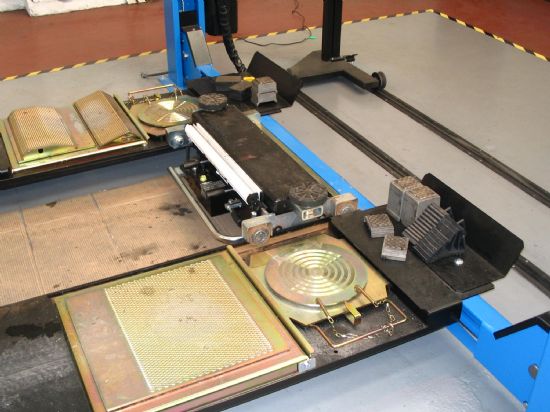What is a Wheel Play Detector?
A wheel play detector, (or wheel play detectors, they can come as single, dual and also twin plates, but more about that further down the page) is an item of garage workshop equipment which is often utilised on vehicle lifts, either four post lifts or scissor lifts and also with in-ground inspection pit set ups. Their primary function is to place loading on the steering and suspension components of a test vehicle. The reason for conducting these tests and using Wheel Play Detectors is to ascertain if there is any play in these components that would therefore need to be addressed for the continued safe operation of the vehicle. Wheel Play Detectors began life over 40 years ago assisting in the inspecting of commercial vehicles steering components and king pins.
How do Play Detectors Work?
To apply loading to the steering and suspension components, wheel play detectors will create both rotational and lateral movement through the use of hydraulic or pneumatic rams, which in turn move the plates that the vehicles front (and sometimes rear) wheels are located on. These movements are done independently of each other, so either a lateral movement or a rotational movement is generated by the wheel play detector. Due to the motion that they create in the vehicle during their use they are also known as Shaker Plates or ATL Shaker Plates.
When to use Shaker Plates?
They are commonly used during an MOT test and also for any inspections of the steering and suspension of a test vehicle, although if you can believe it some garages still choose to use a second person to manually manoeuvre the wheel for the inspecting of these components. However, there are two main problems with the original ‘two person’ method, firstly, it is difficult and heavy work for the person manoeuvring the wheel. Secondarily, the test vehicle has to be lifted off the ground so the person manoeuvring the wheel is actually able to move it, as a result the components are not being tested and inspected in a ‘real world’ setting under load.
Single, Dual and Twin plate systems?
Play Detectors have various names for the different approaches to creating the two required movements. You can have one play detector plate / unit that can do both required movements, this can be located under either the left or right wheel on the vehicle lift. Alternatively you can have two separate plates, with one under the left wheel and the second one under the right wheel. With this type of arrangement one plate creates the rotational movement and the other plate creates the lateral movement.
Unfortunately the names that are commonly in use for these systems are almost interchangeable, as in a Single / Twin / Dual Play Detector plate might be referring to the movements (lateral or rotational) created by a single plate or alternatively it may refer to the number of plates required to create the two required motions (lateral or rotational).
It will always be best to ensure you are very clear when specifying what type of play detector system you are referring to although they all achieve the same result. The only time that you may wish to choose a single plate unit that does both movements over dual plate units that each do the separate movements is when working with in-ground pits, as this can reduce the amount of work required at the civil work stage.
Pneumatic or a Hydraulic Wheel Play Detectors?
There is a choice when it comes to wheel play detectors and both of these systems have little difference between them in their approach to driving the play detectors. However, there are two main reasons why over time hydraulically powered shaker plate systems have become more popular. The first reason is that hydraulic shaker plates are very robust and reliable in their use. The second factor in why hydraulic play detectors have become the clear leader of the two systems is that the ATL shaker plates are commonly factory installed on four post lifts and scissor lifts when they are ordered, with these car ramps being nearly always being hydraulically driven. The wheel play detector plates then utilise the vehicle lifts hydraulic power system.
How does the operator control the shaker plates?
Having covered the reasons for why you would use ATL shaker plates and the principles of how they work, the final point to cover is how the operator controls them. The person utilising the wheel play detectors needs to be able to control the action of the units while watching the resulting movement of the steering and suspension components. To achieve this they will use a remote controlled system with push button controls, often with an actual wire heading back to the control unit (although wireless models are now becoming available). The controllers nearly always have a torch light set in the end of the remote to assist the operator see what they are inspecting, as by the very nature of what they are inspecting is often in the shadows. This has lead to the play detector controllers often being called ‘Torches’ even though is is definitely only their secondary function.
What can Lions Equipment do for you and your ATL Shaker Plate requirements?
There are three main areas that Lions Equipment can help you with shaker plates. We firstly have over 40 years experience in specifying Class IV (Class 4 MOT ) and Class VII (Class 7 MOT) ATL Lanes and Bays, so if you are looking for advise or a quote on a new MOT installation then we have the knowledge to help you. We have also been servicing and repairing wheel play detectors since they first came into operation so are able to diagnose any fault that your units may be suffering from and repair it. Finally, having worked with shaker plates for so many years and seen the faults that have affected the manufacturers own handsets we have designed our own shaker plate remote control, the LE300, which works with nearly all Italian shaker plate systems. So if you have any questions regarding ATL Shaker Plates then contact us so we may help you.

